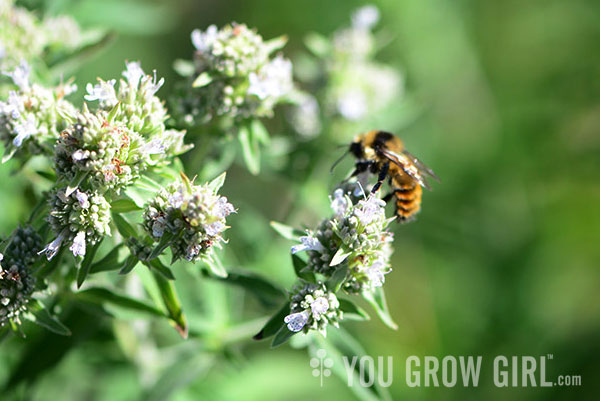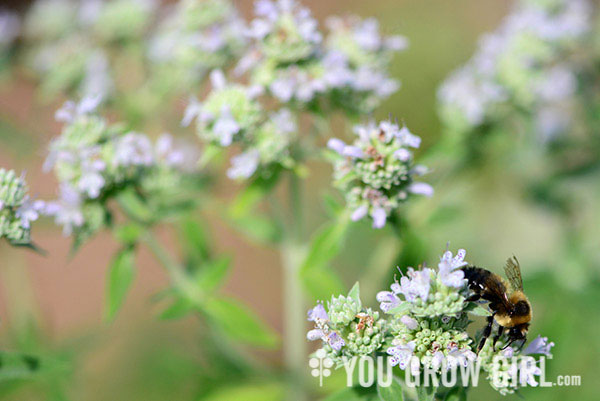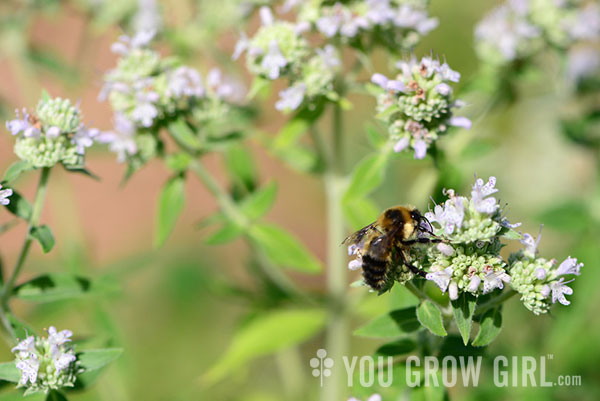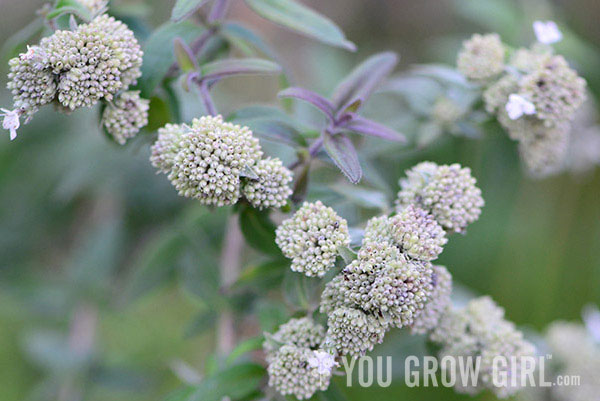
Back in 2010, when I was travelling to promote the release of my second book, Grow Great Grub, I made a stop at a small bookstore in Montreal. Before the event, I went plant shopping with the store manager, who wanted to get a little herb garden planted in front of the shop. In the Jean-Talon market we went into a small produce store with seed shelves lining the front and side walls. There, among many common vegetable garden and herb plants — your basic dill, carrots, hybrid tomatoes, etc — I found a packet of something I had never seen before. It was marked in French, and while my comprehension was “advanced” enough to work out the basic translation, there was no botanical name or further information provided. Back then you couldn’t just whip out your smartphone and do a quick Google search — I think I had a basic flip phone at the time.
What was this mint of the mountain? It was a mystery, so, of course, I had to have it.

Every photo I take of this plant in bloom includes at least one pollinating insect. It’s a very popular source of sweet nectar!
Despite it’s name, Mountain mint (Pycanthemum) is not a true mint (Mentha), but is a relative in the same family, more closely aligned with other members such as bee balm (Monarda) than its namesake. There are approximately 20 species in the genus, all native to (mostly) Northeastern parts of North America, with only the thin-leaved species being edible. The wider-leaved species contain higher quantities of pulegone, an insect repellent compound that can be toxic to the liver. Great for keeping mosquitos at bay; not so great for consumption. Fortunately, the seeds I bought were for Hairy Mountain Mint (Pycnanthemum verticillatum var. pilosum), an edible species that is native to the Great Lakes regions of Canada and the US with a range that extends down into the southern states.
The flowers, when in bloom (mid-late summer) are an absolute pollinator magnet, bringing native bees, butterflies, and wasps into the garden that I have never seen before. They love its pungent, powerful nectar, and so do I. Both the flowers and the leaves are reminiscent of regular mint, but with a twist, and can be used in the same ways. However, where the flavour from Mentha species comes from the essential oil menthol, Pycnanthemum’s mintiness has a distinct spiciness that comes from the essential oil menthone. I use the leaves and flowers fresh in homegrown herbal tea blends and dry them at their peak (flowers and leaves) to enjoy through the winter months. They are also commonly used dried in potpourri mixes and I think it would also work well in a bath tea blend.

This year (2018) I am selling mountain mint seed through my seed shop.
Not only is it a must-have for attracting pollinators, but this edible and medicinal plant is gorgeous, with soft, hairy leaves and stems topped with clusters of white to pale lavender blooms that are dotted with purple spots. The plant grows to about 2-3 feet tall. Like mint, it is a hardy perennial, overwintering down to temperatures as low as -20F and will survive in a range of soil types and light exposure. Here in Toronto, mine thrives in one of the hottest, sunniest spots in my garden where the soil is sandy and often dry. This is a part of the garden that I rarely irrigate or amend the soil nutrition is also quite minimal. The plants that thrive there are tough! If growing in a hotter, more southern climate, I suggest locating it in a spot that has a little bit of sun and heat protection, or slightly moist soil. Regardless, it is much more drought tolerant than regular mint, and also much less invasive. While Mentha species tend to spread by runners, mountain mint grows in a clump and has never tried to take over its bed. How polite!

The Details:
- Hardy USDA zones 4-8
- Prefers full sun exposure and well-draining soil, but is adaptable to a range of conditions.
- Blooms late in the season.
- Native perennial.
- Flowers and leaves are edible and make a wonderful substitution for mint.
- Save seed once the seedheads have dried on the plant. They easily fall out — wrap seedheads with paper bags.
- Container Growing: I’ve never attempted this, but given its tough adaptability to drought and shallower root system , I think this would be easily achievable. However, in colder climates I recommend a very large container, trough, or planter box in order to ensure that it makes it through winter.
- Growing from Seed: Direct sow into the garden in early spring, as soon as the soil is “workable.” Scatter or press seed lightly, but do not bury as it requires light to germinate. Alternatively, start seed indoors 6 weeks before the last frost. Again, press into the soil, but do not cover and keep moist until germination. Transplant outdoors once all danger of frost has passed. Once established this is a tough perennial. Note: I’ve never required cold stratification to encourage germination, but if you do have problems I suggest trying it, or scattering the seed more lightly on the soil surface.
Resources:
- Purchase a pack of mountain mint seed from my garden here
- The Complete Herb Book by Jekka McVicar
- Henrietta’s Herbal
How beautiful! Love seeing all those bees hard at work.
I’ve grown Mountain Mint in central PA for decades and can attest that it draws beneficial bees by the hundreds. I’ve counted more than 12 different types of non-aggressive bees, tiny bees, and blue winged wasps at any given time on this mint. Last summer I set out to count the bees on a sunny day, in a blooming section 1 foot by 5 feet. There were hundreds! I use it to edge my vegetable garden. My 90 year old father uses the leaves for tea in the winter, saying it reminds him of the very low growing mint he used to pick as a child on the nearby mountain. It is easy to grow, smells great, can be used in bouquets and dried, but even better, it is an excellent summer to fall food source for good bees!
I have mountain mint is my small garden. I think the foliage is so pretty and it certainly is a bee magnet. I was so happy to discover it when a friend showed me her great clumps.
Oh! So that’s what it’s called, I’ve been looking for that for a long time! :)